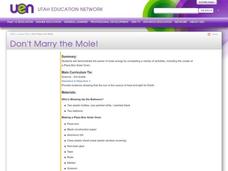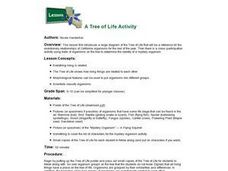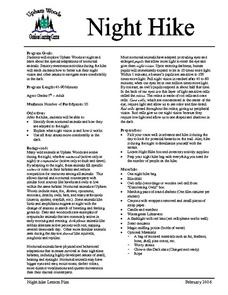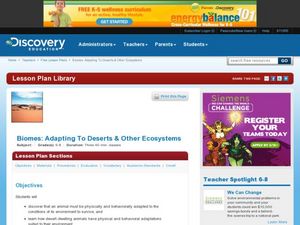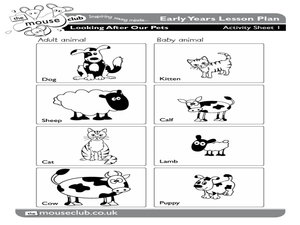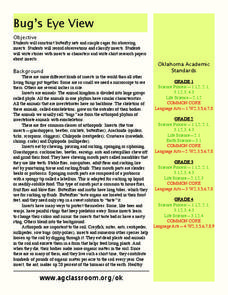Curated OER
Insects
Young scholars study the characteristics and basic needs of insects. They compare and describe similarities among insects. They examine the body structure, covering, and movement of insects and also, examine insect life cycles in this...
Curated OER
The Grouchy Ladybug By Eric Carle
Second graders complete a unit about ladybugs based on Eric Carle's, The Grouchy Ladybug. They complete comprehension questions, categorization activities, Venn diagrams, and choral readings of Susan M. Paprocki', Little Red Bug. As they...
Curated OER
Classification of an Echinoderm
Students study starfish through dissection. In this biology lesson plan, students explore the lives of starfish as they view a slide show, observe parts of echinoderms, and compare the classification of the starfish with other...
Curated OER
Eastern Screech Owl
In this screech owl worksheet, students complete activities to learn about screech owls after reading Screech Owl at Midnight by C. Drew Lamm. Students learn how to attract owls, investigate owls in their community, and define words...
Curated OER
Hypothesis
Students study how to write several hypothesis. In this hypothesis activity students divide into groups and complete several hypothesis.
Curated OER
The Parts of an Insect
Learners examine various insects. They discuss the parts of an insect and the environments in which they live. Students explore the importance of insects to our environment. They draw an interpretation of their insect and label its parts.
Curated OER
Desert Animals
Learners survive within an ecosystem, an animal must be physically and behaviorally adapted to the conditions of its environment.
Curated OER
Don't Marry the Mole!
Third graders demonstrate the power of solar energy by completing a variety of activities, including the creation of a Pizza Box Solar Oven.
Curated OER
One of These Things is Not Like the Other
Students examine sets of four or five organisms and determine which organism in each set doesn't "belong", and determine a variety of characteristics that explain why it doesn't belong.
Curated OER
Ant City
Students develop an ant colony that adults and children can visit. Students create different areas including places where tourists can view live ants, play ant games, research facts about ants, and create ant art. Students serve as...
Curated OER
A Tree of Life Activity
Young scholars solve a mystery of the identification of a unknown organism by comparing its morphological characteristics to those in a tree of life classification poster. They compare the observable characteristics of the specimen and...
Curated OER
Centipede or Millipede?
Students discuss millipedes and centipedes in terms of their classification as arthropod. Using a diagram, students categorize and compare and contrast the characteristics of millipedes and centipedes based on their discussion of...
Curated OER
Night Hike
Students explore Upham Woods at night and investigate about the special adaptations of nocturnal animals. They identify three nocturnal animals and how they are adapted to the night. Students explain what night vision is and how it works.
Curated OER
Barn Owl Pellet Lab
For this lab worksheet, learners dissect a barn owl pellet then identify the different small animals found in the owl pellet. Using class data they calculate percentage present as well as complete 8 post lab questions.
Curated OER
I Want To Know More...
In this animal research worksheet, students choose an animal they want to learn more about and then research the answers to twelve questions about the animal of their choice.
Curated OER
Oddball Out- Finding the Item that Does Not Belong- Invertebrates
In this visual comparison worksheet, student look at 4 rows of invertebrates. They determine which one does not belong in the row. They check their work with the answers that are given at the bottom of the page.
Curated OER
Reading - Glaciers
In this online interactive glaciers worksheet, students respond to 10 fill in the blank and multiple choice questions regarding the information included in the provided paragraphs.
Curated OER
Observing Compost Invertebrates
Second graders examine compost piles and what invertebrates help decompose the organic matter. In this compost invertebrates lesson students collect invertebrates found in a compost pile and examine them.
Curated OER
Biology Trivia
In this biology trivia activity, students write short answers to 101 questions about animal classification, human anatomy, animal facts, and attributes of organisms.
Curated OER
Animal Quiz
In this animals worksheet, students complete short answer questions in a quiz about all different kinds of animals. Students complete 30 questions.
Curated OER
The Hidden World
Students examine dust mites and other allergens. In this dust lesson students complete a lab activity on dust mites.
Curated OER
Biomes: Adapting To Deserts & Other Ecosystems
Students examine how animals must be adapted to the conditions of its environment to survive. In this biomes instructional activity students research desert adaptations then discuss how these animals have survived.
Curated OER
Looking After Our Pets
Students explore animal lifestyles by illustrating images. In this pet care instructional activity, students discuss their own pets and the conditions animals need to survive in both nature or a home. Students draw snakes and complete an...
Curated OER
Bug's Eye View
Students explore biology by writing fictitious stories in class. In this insect life lesson, students identify many different types of insects in the animal kingdom and the classifications they fall into. Students collect insects on a...
Other popular searches
- Spiders and Science
- Life Science Spiders
- Science Spiders vs Insects
- Earth Science Spiders
- Elementary Science Spiders
- Physical Science Spiders







